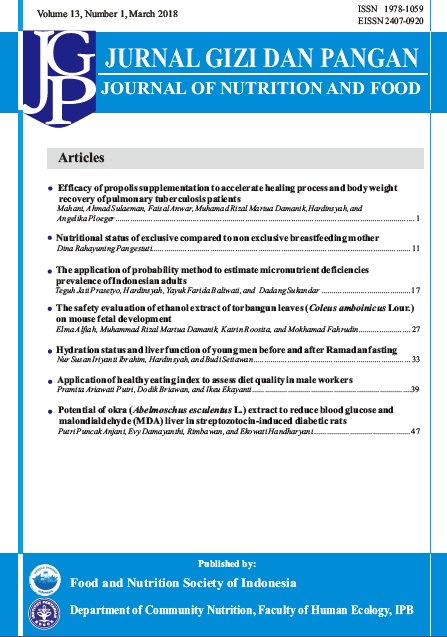The safety evaluation of ethanol extract of torbangun leaves (Coleus amboinicus Lour.) on mouse fetal development
Abstract
The purpose of this study was to evaluate the safety of ethanol extract from torbangun leaves on mouse fetal development. This research used 24 female pregnant mouse. The leaves extract was administered orally at dose level of 0; 0.56; 1.68 and 3.36 g/kg body weight. The extract was given from the first day until the eighteenth day of pregnancy period. The ethanol extract of Torbangun leaves contains flavonoids, saponins, tannins, and steroids. The result showed that consumption of 3.36 g/kg torbangun leaves extract had led to significant differences in the decrease of maternal weight change, number of live fetuses, fetal weight, and fetal length. Consumption of Torbangun leaves extract during pregnancy should be avoided due to its potency to interfere the fetal development.
References
Damanik R, Wahlqvist ML, N Wattanapenpaiboon. 2004. The use of putative lactagogue plant on breast milk production in Sumalungun, North Sumatera, Indonesia. Asia Pac J Clin Nutr 16(4):S87.
Damanik R, Wahlqvist ML, Wattanapenpaiboon N. 2006. Lactagogue effects of torbangun, a bataknese traditional cuisine. Asia Pac J Clin Nutr 15(2):267-274.
Damanik R. 2009. Torbangun (Coleus amboinicus Lour.): A Bataknese traditional cuisine perceived as lactagogue by Bataknese lactating women in Simalungun, North Sumatera, Indonesia. J Hum Lact 25(1):64-72.doi:10.1177/0890334408326086.
Damanik R, Silitonga F, Siagian PH. 2009. Effects of addition of torbangun leaves (Coleus amboinicus Lour.) in feed on mice reproduction and milk production. Di dalam: Tontsirin K, Wasantwisut E, editor. Annals of Nutrition & Metabolism [Internet]. [2009 Oktober 4-9]. Bangkok (TH): Karger; [downloaded 2016, June 6]. Available online: http://repository.ipb.ac.id/handle/123456789/57286.
Devi M, Syarif H, Damanik R, Sulaeman A, Setiawan B, Dewi R. 2010. Suplementasi daun torbangun (Coleus amboinicus Lour.) untuk menurunkan keluhan sindrom pramenstruasi pada remaja putri. PGM. 33(2):180-194.
Ehrenberg HM, Dierker L, Milluzzi C, Mercer BM. 2003. Low maternal weight, failure to thrive in pregnancy, and adverse pregnancy outcomes. Am J Obstet Gynecol 189(6):1726-1730.
Ekor M. 2013. The growing use of herbal medicines: issues relating to adverse reactions and challenges in monitoring safety. Front Pharmacol 4(177):1-10. doi:10.3389/fphar.2013.00177.
Haeussner E, Schmitz S, Koch FV, Frank HG. 2013. Birth weight correlates with size but not shape of the normal human placenta. Placenta 34(7):574-582.
Ho M, Li T, Su S. 2011. The Association between traditional Chinese dietary and herbal therapies and uterine involution in postpartum women. Hindawi Publ Corp 2011(918291):1-9.doi:10.1155/2011/918291.
Hood RD. 2006. Developmental and Reproductive Toxicology: A Practical Approach. Edited by Ronald D. Hood. 2nd Edition. Boca Raton: CRC Press.
Ishikawa H, Seki R, Yokonishi S, Yamauchi T, Yokoyama K. 2006. Relationship between fetal weight, placental growth and litter size in mice from mid- to late-gestation. Reprod Toxicol 21(3):267-270.
Jahnke GD, Price CJ, Marr MC, Myers CB, George JD. 2006. Developmental toxicity evaluation of berberine in rats and mice. Birth Defects Research 77(3):195-206. doi:10.1002/bdrb.20075.
Johns T, Sibeko L. 2003. Pregnancy outcomes in women using herbal therapies. Birth Defects Res B Dev Reprod Toxicol 68(6):501-504.doi:10.1002/bdrb.10052.
Liu RH. 2003. Health benefits of fruit and vegetables are from additive and synergistic combinations of phytochemicals. Am J Clin Nutr 78(3):517S-520S.
Lu FC. 2006. Toksikologi Dasar: Asas, Organ Sasaran, dan Penilaian Risiko. Jakarta: Penerbit Universitas Indonesia (UI-Press).
Lukhoba CW, Simmonds MSJ, Paton A. 2006. Plectranthus: A review of ethnobotanical uses. J Ethnopharmacol 103(1):1-24.
Ramalakshmi P, Subramanian N, Saravanan R, Mohanakrishnan H, Muthu M. 2014. Anticancer effect of Coleus amboinicus (karpooravalli) on human lung cancer cell line (A549). IJDR 4(11):2442-2449.
Rosidah, Hasibuan PAZ. 2014. Cytotoxic effect of n-hexane, ethylacetate and ethanol extracts of Plectranthus amboinicus, (Lour. Spreng.) on HeLa and Vero cells lines. Int J PharmTech Res 6(6):1806-1809.
Setyawati I. 2009. Morfologi fetus mencit (Mus musculus L.) setelah pemberian ekstrak daun sambiloto (Andrographis paniculata Nees). Jurnal Biologi 13(2):41-44.
Suryowati T, Rimbawan, Damanik R, Bintang M, Handharyani E. 2015. Identifikasi komponen kimia dan aktivitas antioksidan dalam tanaman torbangun (Coleus amboinicus Lour.). J Gizi Pangan 10(3):217-224.
Sutomo AE, Sitorus TD, Pribadi A. 2015. The teratogenic effect of the mindi (Melia azedarach L) leaves ethanol extract on mice (Mus musculus) fetus. AMJ 2(2):221-225.
Timbrell JA. 2009. Principle of Biochemical Toxicology. New York: Informa Healthcare USA, Inc.
Yakubu MT, Bukoye BB. 2009. Abortifacient potentials of the aqueous extract of Bambusa vulgaris leaves in pregnant Dutch rabbits. Contraception 80(3):308-313.
Authors

This work is licensed under a Creative Commons Attribution-ShareAlike 4.0 International License.





